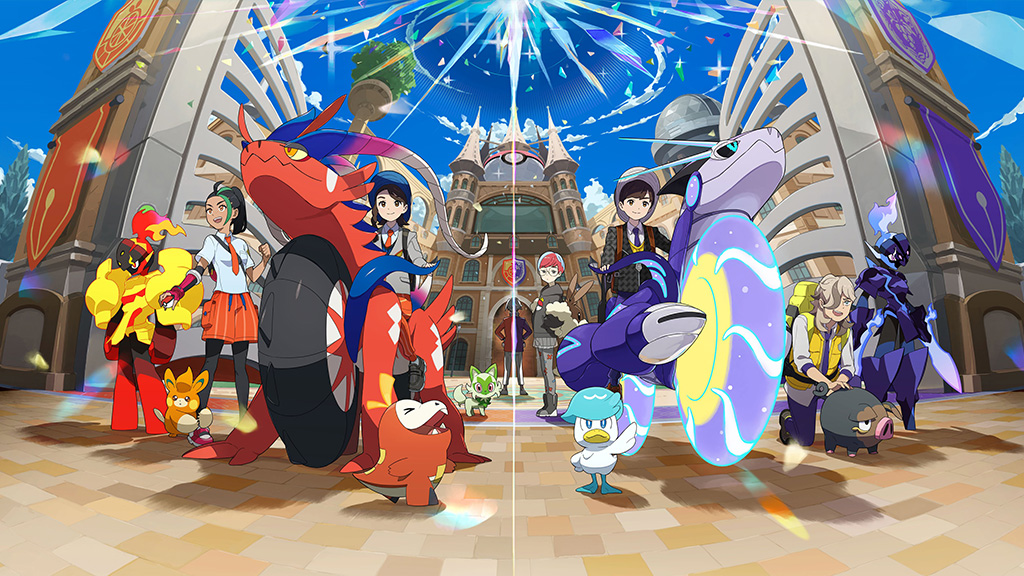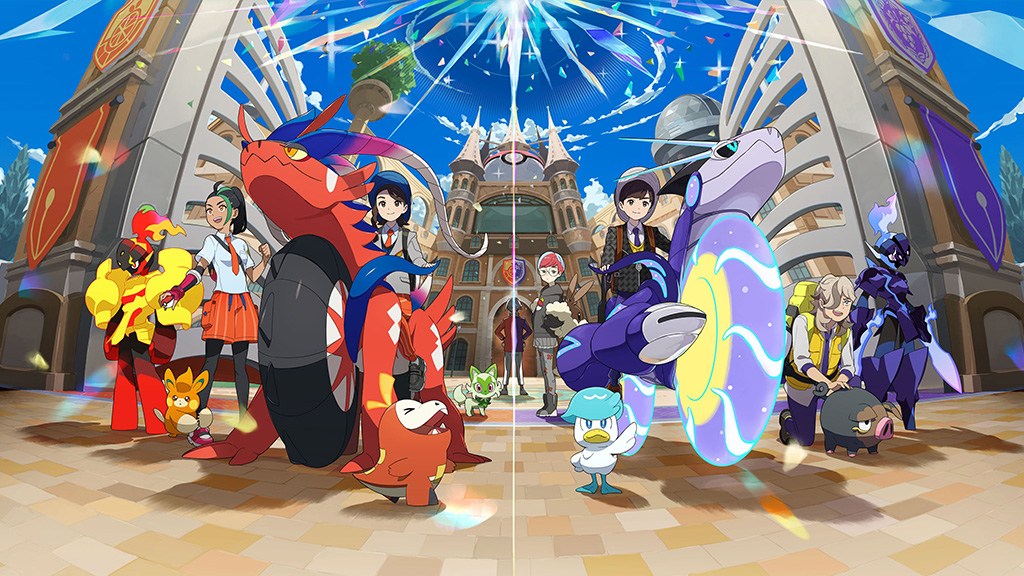
Little trainers can once again enter the world of Pokémon, this time with an open-world environment — and their own Pokémon motorcycle to explore it with!
Pokémon Scarlet and Pokémon Violet are the most recent releases in the series of core Pokémon video games. This new pair of games, both rated E for everyone, has a lot to offer, especially for kids who already love Pokémon.
For those who may not be familiar with Pokémon games, they are traditionally released in pairs. Each game in the set offers some Pokémon types that players can exclusively catch in that version, which encourages trading with other players. For this release, the games are also themed around the past and the future. Pokémon Scarlet has a past version of the legendary Pokémon called Koraidon, while Pokémon Violet has a futuristic one called Miraidon. The two games have different professors (the character who serves as the local Pokémon expert) as well: the sleek, future-styled Professor Turo in Violet and the prehistoric-fashion-wearing Professor Sada in Scarlet. Outside of these differences, the two games — like most paired Pokémon games — offer essentially the same experience. So, choosing one is mostly about choosing an aesthetic, and kids won’t need to have both.
There are a number of things that make these games a fresh Pokémon experience. Though there have been plenty of valid complaints about technical performance issues and the introduction of new mechanics, the games are overall fun and are likely to keep the attention of kids who add Violet or Scarlet to their holiday wish lists.
One of the most exciting of the new elements added in this release is the larger explorable world, which players can venture into almost right away.
The First Truly Open-World Pokémon Game
Scarlet and Violet offer an open-world gaming experience, which has been a big line in the advertising for these games. In video games, open-world means that there is no set path to follow — players are able to complete the game’s objectives in whatever order they want to and explore almost the entire virtual world from the beginning. Pokémon Legends: Arceus, a Pokémon game that debuted last year, offered some open-world elements but is definitely not as fully explorable right away as Scarlet and Violet.
And these new games offer a large world of Pokémon to delve into. After a bit of introductory content, I was quickly let loose in the wider area. It’s almost overwhelming initially, as there are so many different Pokémon to catch right away. I soon gave up on trying to complete my Pokédex (in other words, catching one of every type of Pokémon) and decided I could come back to that goal.
The areas are fun to explore, though kids who are used to other Pokémon games letting them go in every little house might be surprised to find that a lot of the doors in this game are, in fact, locked. And though there are plenty of characters running around the cities, there are fewer who will actually talk to the player than in some previous games. That said, many of the characters who players do meet are more detailed than what I’ve seen from Pokémon before, so it arguably evens out.
The world is enjoyable to navigate as well, particularly while riding Miraidon or Koraidon, the legendary Pokémon of these games that essentially act as a motorcycle. The riding is smooth and unlocking new abilities for Miraidon or Koraidon, like surfing over water, can give players access to new Pokémon as well as new areas in the larger map.
The open-world game doesn’t mean there isn’t some level of direction. In addition to unlocking new areas with Legendary Pokémon abilities, players start off with three main story quests in the game, choosing which they’d like to focus on first. All three of these quest stories are fun and get players invested for when the storylines ultimately come together.
Every one of the three quests has its own associated mechanics, too. To earn the right to battle the leaders of the gyms in the gym quest, players must complete different “gym challenges,” which include everything from a game of hide and seek with Pokémon to winning an auction. There are plenty of Pokémon battles and fun mechanics to be found in the other two quest lines as well, which focus on searching for the rare Herba Mystica and battling a group of delinquent students called Team Star.
Each of the three main quests is great, though my favorite was the Herba Mystica quest. Without spoiling things too much, the character Arven and his Pokémon get to shine in a way that I found very endearing!
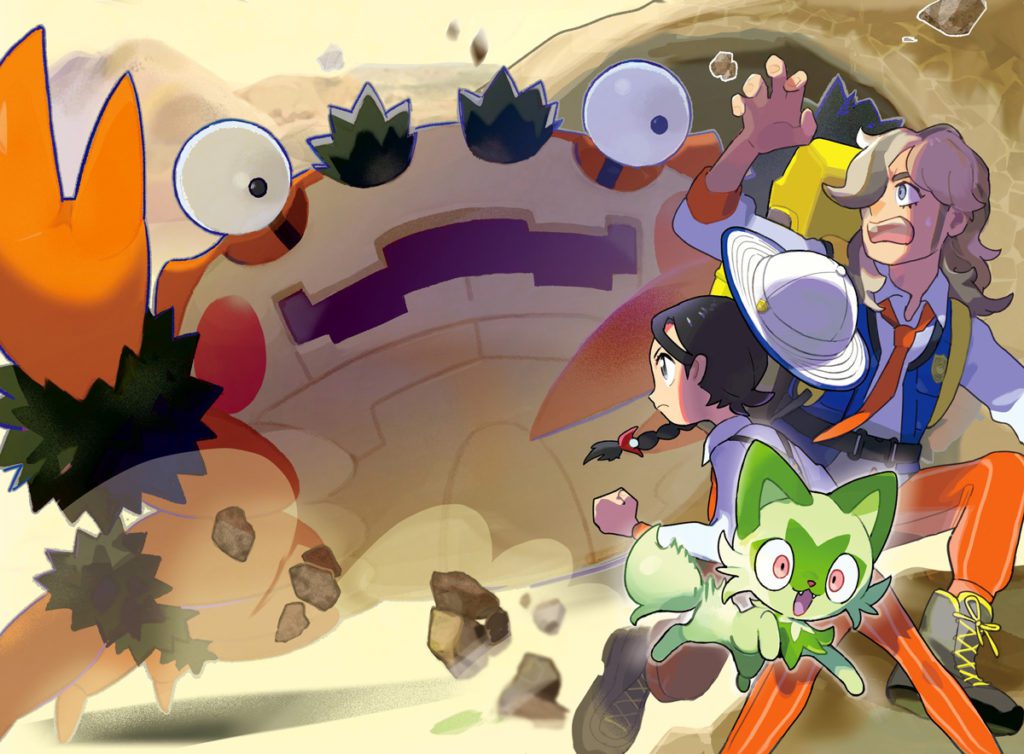
Speaking of characters, that was a real highlight of the game experience. The characters are well-made, with interesting designs and motivations. This is something that has been hit or miss in Pokémon games for me — actually feeling like the characters in the game are my friends. I think this game really did get the vibe of friends right, which is great for younger gamers as a positive lesson about supporting the people around you. I ended up being super fond of multiple non-player characters (NPCs) that I was doing quests for.
There are three characters most closely associated with the three main quests. Nemona is the battle-crazy rival mostly tied to the gym quests, and she’s a delight. Arven is working to find the Herba Mystica and is a character I very much warmed up to. And Penny brings players rewards after Team Star encounters (and she has some secrets to discover). They’re all fellow students and really do feel like a part of the experience, rather than just side characters or nuisances players have to pause and battle sometimes.
The teachers at the school your character attends are also lovable and tie into larger events in the game. Players can also take their classes to increase their friendship with them, unlocking rewards.
And as is tradition with any Pokémon game, the gym leaders (characters who challenge the player to a Pokémon battle where they can earn a badge if they beat them) have out-there designs and out-there personalities. My personal favorite was the electric-type gym leader Iona, who is designed as a famous streamer in the Pokémon universe. Any kids who enjoy gaming and gaming streams are likely to find her fun.
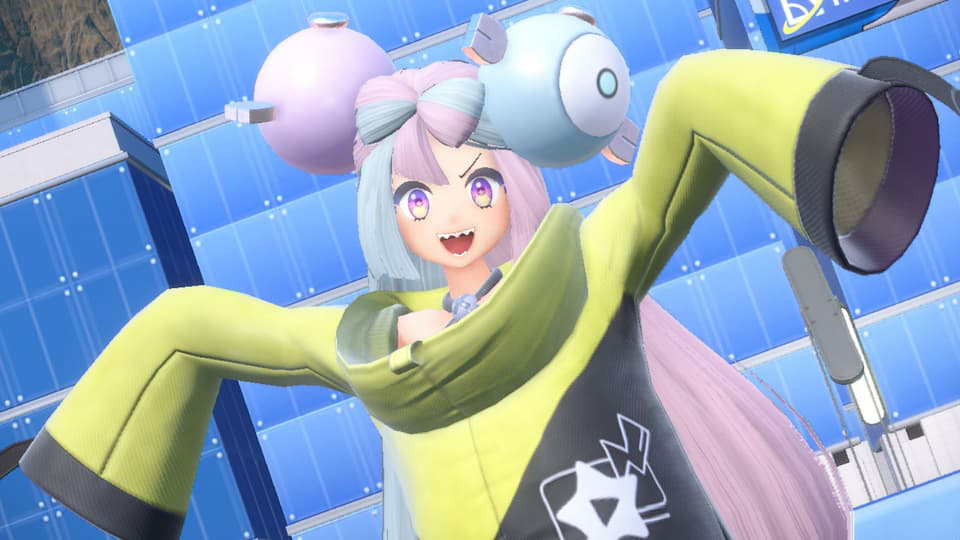
Character Customization Is a Win
The first thing any player will do in these games is make their character. The customization screen lets players change all sorts of features, such as eye shape, eye color, hairstyle, hair color, skin tone, and more. It’s a pretty respectable amount of customization, particularly for games that previously had none. And there are a variety of hair types featured, which is always nice to see.
Once trainers get into the game, they will find even more customization options in the shopping experience. By visiting various shops in the game, kids can accessorize their in-game avatars with backpacks, socks, shoes, glasses, hats, and gloves. I do wish more of the towns had shops, but the inclusion of a high-fashion store — modeled after brands such as Gucci and Versace — was super fun. I definitely spent all my Pokémon money to have my character decked out entirely in Pokémon Gucci.
Two areas that are not so customizable in the fashion department are shirts and pants. As a student of either Naranja Academy (Pokémon Scarlet) or Uva Academy (Pokémon Violet), players are always going to be in their school uniform. They can choose from four different uniforms based on the seasons, but sometimes it can be a bit tricky to match accessories to that.
But what design is more important than any character design? The design of the Pokémon!
The New Pokémon Have a Lot of Personality
As mentioned previously, the Pokémon in this game run around the main area, much like in Pokémon Sword and Shield, ready to be caught. This gives these eclectic creatures an amount of personality that’s really pleasant. Seeing a group of Hoppips gathered together, for example, makes the area feel more alive and full.
The main legendary Pokémon of the games, Miraidon and Koraidon (who, like in other Pokémon games, are one-of-a-kind powerful Pokémon), come into the player’s possession pretty quickly and become a main component in the game. This element was nice because it invests players in the legendary Pokémon early on — although it is funny to see a brand-new student in possession of a hyper-powerful Pokémon!
The other new Pokémon introduced in this game are decently well-designed, in my opinion. Like any new release in the series, there will be some designs people dislike, but I think the overall looks of the new Pokémon were well-executed. I particularly liked Smoliv, Tinkaton, and Lokix. With a whole pile of new Pokémon to choose from, any young trainer is likely to find one to add to the list of favorites.
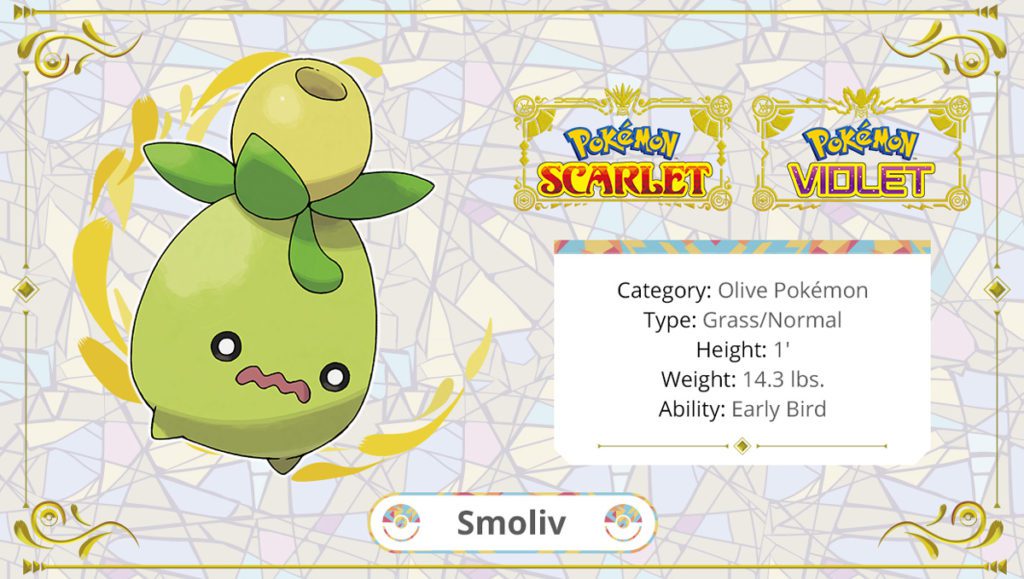
And there are adorable ways to interact with the Pokémon you catch, which might even teach kids a thing or two about responsibility! When players select the picnic option in their menu, the character sets up a little picnic table and lets all the Pokémon in their team roam. Players can wash their Pokémon, play with them, and feed them sandwiches to get bonuses.
For more advanced Pokémon players, it’s also easier to get shiny Pokémon early on using this mechanic. Shiny Pokémon are rarer versions of Pokémon that have a different color scheme. Going to outbreaks and beating a number of Pokémon, then starting a picnic repeatedly to respawn the outbreak Pokémon, can let players reroll to try and get a shiny. I’ve already caught a shiny Rotom and shiny Fletchling using this method.
The game also introduces a new feature, much like the Dynamax and Mega Evolutions that launched in previous Pokémon games, called Terastallizing. Terastallizing a Pokémon lets players get weird with Pokémon type combinations. Each Pokémon has a type that is effective or not effective when battling against other types. For example, a water type can more easily beat a fire type. Terastallizing changes a Pokémon’s type, boosts some moves, and also gives that Pokémon a temporary crystal-like appearance. This adds a whole level of new potential combinations or power boosting to the game.
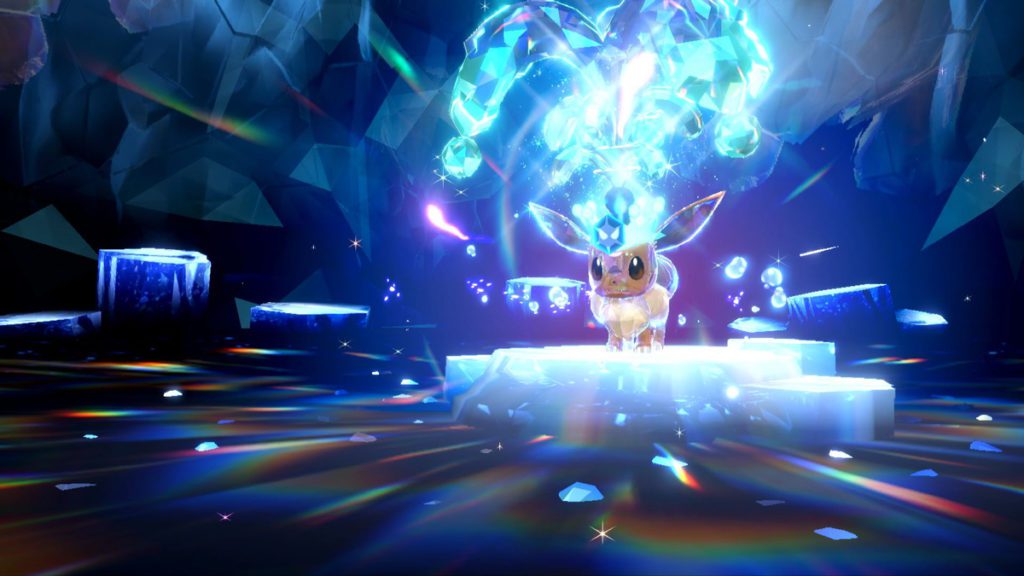
So the story, characters, and Pokémon are all solid, but what about the other non-terastallize mechanics? It is a game, so that of course is going to matter. And there is one thing that may be a bit of a bumpy ride for people.
There Are Some Performance Issues
There’s no getting around it — the games have some performance problems. I didn’t encounter anything that just stopped the fun permanently for me, but I ran into some trouble spots for sure. I definitely still think the game is worth playing, but it’s good to be be aware of this going in.
The framerate can be quite low when running around towns with NPCs or when there are a lot of Pokémon on-screen. This isn’t one that bothered me all that much, but it can be a bit funny to see. And even outside of framerate issues, the game itself sometimes feels a little slow. Battles can take a while even when they’re running well, particularly if Pokémon have abilities that affect a lot of things, such as Klawf’s ability Anger Shell, which lowers a ton of enemy stats.
More serious issues I experienced included the game crashing once while I was playing with friends and falling through the ground another time. These were the only two major hiccups in a good number of hours playing but that kind of thing can be uniquely frustrating for kids.
I wouldn’t say the games are unplayable — far from it! — but it might be a good idea to be ready to help younger players get back on track if things crash or some sort of error occurs. Generally, just restarting the game from the last autosave should do the trick.
Additionally, it does sound like fixes are on the way. In an update announcement posted by Nintendo on Dec. 1, the company states “We are aware that players may encounter issues that affect the games’ performance. Our goal is always to give players a positive experience with our games, and we apologize for the inconvenience. We take the feedback from players seriously and are working on improvements to the games.”
Additionally, there are some mechanical elements of the new, open-world style that players will want to be aware of going in.
There Isn’t Any Level Scaling
The game doesn’t have any level scaling, which means that every trainer a player can fight or Pokémon a player can catch has a set level, regardless of the player’s level or experience. As a result, young gamers can easily run into an area or a Pokémon that’s too high-level for them to handle. Or they might go one direction, gain experience, then come back to an area where the battles are now really easy. The latter happened to me a couple of times and made some gym fights a little unexciting. Either of these scenarios has the potential to be frustrating to a kid playing, especially when there isn’t a ton of guidance on which way to go.
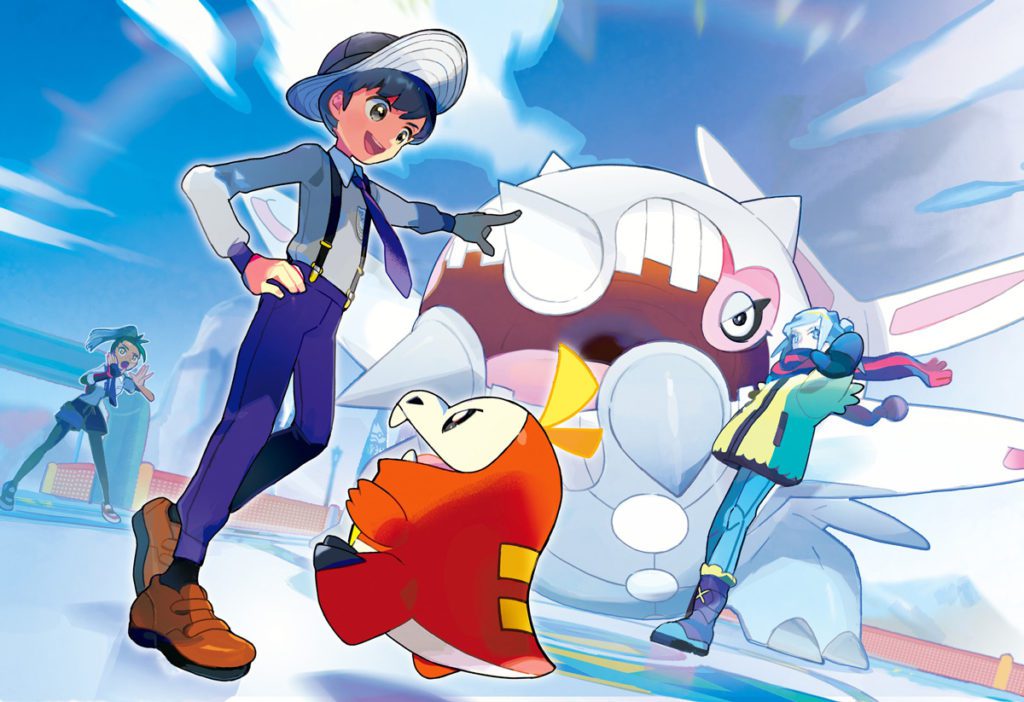
While I would’ve appreciated the map having level range labels on it, if a kid ends up a bit frustrated with the lack of structure, it is easy enough to look online for the level orders of the three main questlines. There are even guides that mix the three paths together, giving players a way to jump between the stories without finding themselves in a battle that’s too tough to beat. All this said, there is something kind of fun about running around and finding your way, even if it’s not as intuitive as it could’ve been.
And this game does let players have company in the running around process, with a much more extensive multiplayer than previous Pokémon offerings.
Let’s Play Together
The multiplayer elements in Scarlet and Violet are fairly easy to set up. Players can go into the Poké Portal and either set up a local room or an online one. The local room is for people who are in the same house playing on different Switches, and the online one is for people to play remotely with one another.
There isn’t a ton to do together in the early game, but it is fun to see a friend also running around the map. Like in Sword and Shield, players can team up to do raid battles together. They can also hunt for Pokémon with one another, take selfies, or just go shopping and compare the resulting outfits.
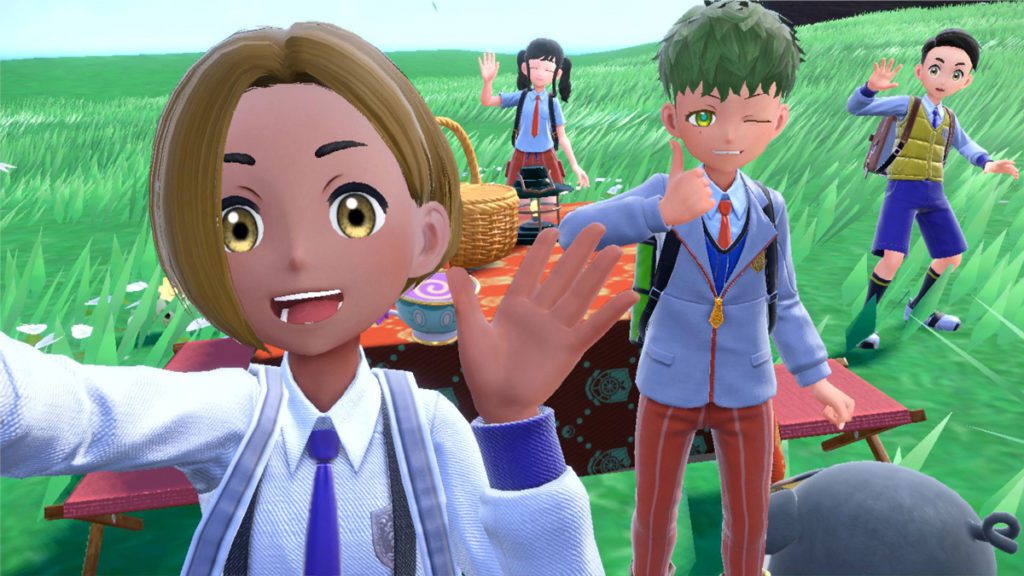
It’s also relatively safe for kids to use. There aren’t any chat features to worry about someone saying something inappropriate, and shared player info is decently minimal. Parents should encourage kids to not use their full names as their character name, as that is viewable if you battle or trade with other players. It’s clearly a game designed with kids in mind, but it’s never a bad idea to have a chat about online safety.
The online multiplayer is another example of something in these games that’s very promising for future games if it gets more fleshed out, and is already pretty fun as is.
Overall, Pokémon Scarlet and Violet are flawed but quite entertaining Pokémon games. Despite some of the technical challenges, I’ll admit I fully recommend Violet and Scarlet. Kids will enjoy this fresh take on the classic Pokémon format. The games are cute, compelling, keep your attention, and have a story that, in my opinion, is genuinely an improvement over previous games. Just be ready for an upset or two if things crash, and be aware that older kids might notice some of the bits that feel more unfinished.
Pokémon Scarlet and Pokémon Violet bring new things to the picnic table that make me eager for the future of Pokémon gaming!

